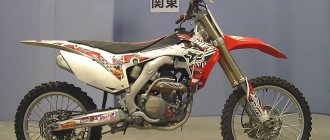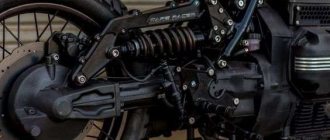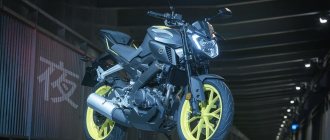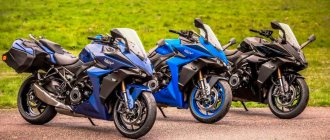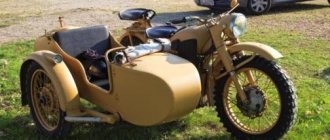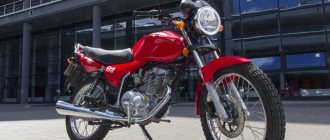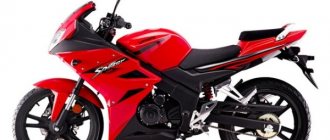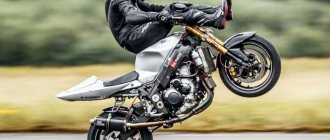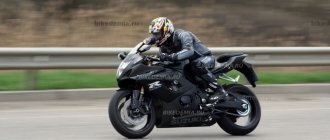Russian motorcyclesMotorcycles "Voskhod"
Soviet factories served motorcyclists faithfully: many well-known models rolled off their production lines, but after the collapse of the USSR, some enterprises had to close or adapt to work in the new economic system.
A flood of foreign goods poured into the Russian market, including motorcycles.
It was decided to transform the Voskhod motorcycle, popular in the Soviet Union (manufactured by the Degtyarev Plant), into a new model that could compete with foreign motorcycles - it was the Owl.
Knight's move
ZID Sova 200 – front view.
ZID Sova 200 – rear view.
Before finally handing over the assembly line to Lifan, which began to be assembled at the same plant, the engineers came up with an idea:
“What if we cram a 200cc engine onto the Sova? Most users say that the motorcycle engine is frankly weak. With the new engine, torque should increase, and with it dynamics and speed. If it doesn’t work out, let them gather the Chinese.”
The decision turned out to be successful . After some time, the conveyor is restarted, and a new Owl is born. This is how the Zid Owl 200 motorcycle was born. Since the motorcycle has a 2-stroke engine and does not meet current environmental standards, it was considered unprofitable to remake it. In 2000, production was closed.
Model "Owl 200" in 1977-1979: thirst for speed
During this period, the designers made a lot of effort to significantly increase engine power, which increased to twenty-four and a half horsepower at 6700-7900 rpm, while maintaining the same displacement of 173.7 cubic centimeters and maximum torque of up to 1.6 kgf. m (16 Nm) at 5600 rpm. Thanks to the reconfiguration of the bore in the cylinder, crankcase and new cylinder head, the compression ratio increased to 10.4. A mechanical change was made to the front fork: the diameter of the pipe increased and the shock absorber was improved to the greatest extent possible at that time. The fork travel was increased by twenty millimeters and amounted to one hundred sixty-nine and a half. Now the Owl 200 motorcycle began to reach a maximum speed of up to one hundred and five kilometers per hour, while its dry weight was one hundred and twenty-one kilograms.
Specifications
Due to the large number of complaints about the engine, engineers drew a new version from scratch. Otherwise, the bike has not undergone any changes.
The Owl's engine is designed to be cooled by counter-flow air. Among the people - air!
It was still the same Sova 175, but with a new, larger engine. The updated version produced:
- working volume - 196.9 cm3;
- number of cylinders - 1;
- number of cycles - 2 (!!!);
- number of valves - 1;
- power - 15.5 hp;
- torque - 18.6 Nm;
- cooling - air;
- fuel supply - carburetor;
Carburetor – Soviet K65K or Czechoslovakian Jikov (from “Java”).
- ignition - transistor (TDI);
- start - kick starter;
- tank volume - 15 l.
Since the production of the bike began even before the widespread transition to 4-stroke engines, even the updated version worked on a 2-stroke circuit. When environmental standards were introduced, half of the motorcycle was not rebuilt. just went out of production .
Requirements for fuel quality, at that time, were very modest. Gasoline AI-80, AI-92 .
Transmission and clutch
Paired with the engine was a 4-speed gearbox. The operating principle is standard, sequential.
Since the maximum speed of the motorcycle was low, it was not necessary to click the gears often. The third one provided normal city driving. The third one allowed us to get under way. The fourth was used only for overtaking. The box worked well and did not cause any problems to the owners .
- The main drive, of course, chain.
The stock chain drive came with a protective cover and was located on the right, which is very unusual by today's standards.
- clutch , oil bath . Power transmission is a cable .
Brakes
Rear drum brake with mechanical drive.
The bike inherited the brake system from its ancestor, the Voskhod.
Independent drums on both axles, mechanical drive.
There were no complaints about the brakes of both the first and second Owls. We didn’t even think about any options during production.
An era of stability
Next model
In 1956, the Minsk plant produced a modernized version of the M1A - M1M. It had a softer ride than its predecessor, which is why in areas with many holes and potholes it could lose stability, which sometimes led to a fall.
Motorcycle M1A
This is one of the shortcomings. The advantages include an increased maximum load and speed, allowing the speedometer to approach the mark of 75 km/h. Also, electrical equipment was used on this motorcycle for the first time in the series. In general, that's all.
Model “M103”
The production of “M1M” lasted five years - from 1956 to 1961. The shift arrived in 1962. It became a generalization of many years of experience of the Minsk plant. The suspension was made stiffer so that riders would no longer fall on bad or simply uneven sections of the road. We changed the filters in the engine to more modern ones, which significantly increased its lifespan.
Motorcycle Minsk M-103
Load capacity and speed were left, in general, unchanged. Fans of the motorcycle were upset that the single-seater design of the device was also left unchanged. However, for this model it was supposed to be possible to purchase an additional seat for a passenger for an additional fee. But who needs it? It would be better if everything was equipped right away, at the factory, as it should be,” Soviet users were indignant.
Model “Minsk”
The next generation change occurred in 1964. Actually, this particular motorcycle had the word “Minsk” in its name; previous versions were called that by the people, for the sake of clarity and simplicity. Compared to its predecessors, it turned out to be more stylish, or something
When designing it, considerable attention was paid to appearance. Engine power also increased to 5.5 hp
And, lo and behold, for the first time on this model there was also room for a passenger.
New word. "M105".
This particular motorcycle can be considered an evolution in the development of this series. A four-speed gearbox was used for the first time. Engine power increased to a respectable 7 hp, which made it possible to reach a speed of 80 km/h. Also, for the first time, a brake light was installed to increase road safety, and a light bulb was attached to the speedometer for illumination. Production lasted until 1971.
Now also with a trunk. “M106”
In addition to the rear trailer for payloads, the tank volume has also increased - 12 liters. And the engine power had now increased to 9 hp, and now the motorcycle could accelerate to a speed of 85 km per hour. The weight of the car was now exactly a hundredweight.
Hipster. “MMVZ-3.111”
Having replaced the previous model in 1973, MMVZ-3.111 stood out for its modern and fashionable appearance. The speed increased to a respectable 95 km/h. A light switch for high and low beams, as well as a direction indicator, appeared.
Motorcycle Minsk MMVZ 3.111
This motorcycle received the “USSR Quality Mark”. A “Sport” model was also released, which had a 12 hp engine.
Cosmetic changes. “MMVZ-3.115”
As the name suggests, no special innovations were introduced. Only the speedometer and switch were moved into separate housings, and a new muffler and headlights were installed. Year of manufacture: from 1976 to 1980.
Logical progress. “MMVZ-3.112”
Expert opinion
Isaac Yakovich Zelder
Soviet astrophysicist, physical chemist, Doctor of Physical and Mathematical Sciences, Academician of the USSR Academy of Sciences, designer, engineer. Hero of Socialist Labor of the USSR.
Yes, this is not a mistake, the next model had a smaller number in its name than the previous one. Some factory marking features.
This motorcycle was externally similar to its predecessor, but was superior to it in a number of parameters. He “lost” the weight by 7 kg, while increasing the load capacity by 10. He became more comfortable to ride. The speed remained the same, but the engine power was now a confident 12 hp. Produced from 1980 to 1995. A number of modifications were made, which were mainly intended for rural areas.
Driving performance,
Despite the increased engine power, the maximum speed did not differ from its predecessor, Sova 175. It was only 107 km/h .
It was not customary to measure the dynamics of acceleration from a standstill to 100 km, but users noted that a motorcycle covers a distance of 400 meters (the standard in many comparisons) in 21 seconds (for an owl 175 - 25 seconds ).
Fuel consumption
Fuel consumption by the standards of classmates is quite impressive - 4-4.2 liters per 100 km .
M-1A "Moscow"
Let's try to build this excursion into the motorcycle past of a great country in chronological order. Let's take the post-war period, well, simply because it is clearer and closer to us.
The motorcycle industry was revived on the basis of the best examples of captured equipment. And a lot of it was brought to the USSR. And now at the Moscow Bicycle Plant they are mastering the production of a copy of the German motorcycle DKW RT125 with a 125 cc engine.
The device is called M-1A “Moscow”. This is the first post-war motorcycle of the USSR - simple and lightweight, which did not require a lot of metal and rubber.
Motorcyclists were trained on this type of equipment in DOSAAF schools. In 1951, production was transferred to Minsk to a newly built bicycle plant. Almost the same model with the index K-125 was produced in Kovrov.
Dimensions and weight
Due to the fact that the manufacturers changed only the engine, in terms of external parameters, the new Owl completely repeated the old one. Naturally, this was later reflected in the merits.
- The dry weight of the motorcycle was 122 kg .
- Curb (additional luggage racks, full tank, all technological fluids) - 145 kg .
- Useful (maximum) load - 200 kg .
Externally the motorcycle had:
- length - 2,100 mm;
- width - 850 mm;
- height - 1,200 mm;
Seat height - 780 mm .
Wheelbase - 1,350 mm .
Ground clearance - 125 mm .
For whom is it intended?
The motorcycle was bought for daily movement around the city, fishing trips or mushroom picking (in dry weather).
Being an updated or export version of the Voskhod, as some users call it, the Owl received the same purpose.
A universal motorcycle designed to carry two people of average height and build on “high-quality” Russian roads.
Unfortunately, the low ground clearance suggested using the bike only on asphalt or well-rolled dirt roads. It’s better not to meddle with it either in light, or even more so in hard off-road conditions.
But the presence of stock luggage racks made it possible to go on a long journey with it. And a complete set of additional parts (handles, footrests, and a saddle no less wide than the driver’s) made it possible for the second number to feel comfortable.
According to user reviews, the motorcyclist had to be between 165 and 180 cm . For tall or short people, control would be difficult.
Photo gallery
The Owl motorcycle is designed for use on roads with different surfaces. It has become more reliable and convenient, and changes have also been made to the design and controls. We invite you to look at a selection of photos of this motorcycle and remember our childhood dream.
Modifications and competitors
ZID Owl 200 Courier is a modification with a rear monoshock absorber and front disc brakes.
The Zid Sova 200 motorcycle itself became a modification of the Sova 175 model, launched by the plant earlier.
And the engineers did not take risks - they did not create new modifications that could be classified as middle or heavy class motorcycles at the factory.
Models of other classes were no longer created. As they say, you can’t assemble an airliner from vacuum cleaner parts. Having a set of parts for a road builder, it will be difficult to make a chopper.
But on other conveyors of the same plant they began to produce new ZiDs and Lifans, which were aimed at buyers from the countries of the Soviet bloc. All of them were small-capacity boats , all belonged to the light class, and any of them could call themselves a competitor to Sova.
The list of specific modifications could take a long time. But they all had one feature that distinguished them favorably from this bike. Motor. Motorcycles subsequently assembled at ZiD , Baltmotors , Irbis and foreign enterprises had a 4-stroke engine with a 2- or 4-valve distribution system in the cylinder head.
How did Voskhod 3M-01 differ from the usual 3M?
As you know, putting a new product into production takes quite a long time.
.
This requires re-equipment of the conveyor, technological approach, etc.,
sometimes such transitions are delayed to the point that the product can hardly be called new. For this reason, manufacturing plants come up with some tricks, and today we will talk about one of these. Namely, about the interesting model of the Kovrov ZID, the latest model of Voskhod.
So here is the model 3M-01
and was the very point of support for launching the production of the new family of motorcycles “ZDK”.
What does it mean? It’s simple: “Voskhod 3m” was outdated, but nevertheless there was a demand for it
and it was simply impossible to discontinue it; this was not done until they converted the line for a new motorcycle, they began to produce a transitional model 3m-01, which for the most part was still the same 3m, but at the same time it took on some innovations from the new generation of ZDK. And what exactly, we’ll talk about this now.
Technical characteristics of Voskhod 3M-01 (3M)
Thank you for your attention, friends, rate the article and write your opinion, do you think 3m-01 has become better than 3m?
Source
Peculiarities
At one time, the model enjoyed good popularity until the beginning of the current millennium, when foreign motorcycles of greater power and comfort became available on the market.
The distinctive details of a motorcycle include many things.
- Motor . At the time of development, two clock cycles were the standard solution, but now this technology is considered obsolete.
- Steering wheel. As users note, the Owl remained a well-recognized Voskhod model, but the steering wheel had a new, sporty look. (not clip-ons, its handlebars are more typical for pit bikes).
High sports steering wheel with crossbar.
- Cases . In some cases they were sold separately, but the user could buy both side bags (made of leatherette) and a rear suitcase. The owner was offered a choice - a standard small rear trunk or a trunk. If the latter was selected, additional options were provided. Standard (what a modern suitcase looks like), with two or more compartments inside, with external pockets for every little thing that might be useful on the road.
- Bag - tablet . You will no longer see this part in the stock configuration of a new motorcycle. Experienced bikers buy it separately. Using special nuts, the bag is mounted on the gas tank cap. You can put a smartphone with a navigator in it, and under it your license and registration certificate .
- Safety bars, which could be additionally equipped with wings to protect the motorcyclist from dirt flying from under the front wheel.
Safety bars were included as standard.
- From the Soviet past, corrugated sleeves on the fork stays .
Estimated cost
The motorcycle was produced until the early 2000s, so it is impossible to get a new model now, but there are many interesting used offers on the market.
It is difficult to name a specific price; the Sova-175 version can be purchased second-hand for about 25 thousand rubles, and the condition will be satisfactory.
A more powerful version will cost the buyer 35-40 thousand rubles. The earlier the motorcycle was released, the cheaper it will cost - this also needs to be taken into account.
The motorcycle will be a real find for collectors of Soviet motorcycles, despite the fact that it appeared after the collapse of the Soviet Union - the shape, base, style and chassis correspond to that time.
In the last years of production (2000-2003), popularity decreased sharply , as affordable foreign models appeared on the market that could offer more comfort and power, so finding an “Owl” today is not so easy.
Flaws
Bearing in mind this, already a real retro bike, talking about shortcomings is at least stupid. However, you can still name a couple:
- Oil consumption . In 2-stroke engines, the oil supply principle is different. It is poured directly into the gas tank at the rate of 200-250 ml per 1 liter of fuel . For a 14-liter tank of the Sova it was necessary ( 14x0.25 ) 3.5 liters of oil for each (!) refill.
- Vibration . For cylinder 1, this is the norm (although this problem has been worked out well on the Sova), but at high speeds the mirror mounts constantly had to be tightened.
- Dashboard . She was taken from her ancestor. Anyone who saw the Voskhod’s tidy also saw it on the Owl. Speedometer with odometer, ignition switch and two warning lights. Fuel and high beams.
and dignity
The powerful central stand is stock.
The advantages of the bike included:
- Modern design . Although some call the analog instrument panel an outright rarity, if you remember the Honda SV 400 , which no one would call old, this part of the same type is there.
- Easy to maintain . One cylinder, no additional sensors and indicators... The motorcycle could be repaired either in a garage or in an open field.
- Accessories . Although the bike is old, during its development the engineers made a big provision for the future. During repairs, parts from bikes produced at a later time are also used.
- Cases . The Owl was one of the first dual-use bikes. With a simple trunk for the city or with additional suitcases for a long trip.
Video
We present to your attention a video featuring the Owl motorcycle, once so popular and desirable. Look what he can do!
Did you like the article? Tell your friends!
Comments (6)
- Sergey:
02/28/2015 at 00:12A good, simple motorcycle in its class that does not require special or special care, and is unpretentious. Very affordable to repair.
Answer
- savnatra:
02/28/2015 at 10:25
Well, of course, I wasn’t familiar with this Owl, but the old Voskhod was still that problematic motorcycle. At least for me. I think Minsk is better too
Answer
- Andrey Dobryansky:
03/01/2015 at 10:14
I remembered my distant childhood. My brother took me for a ride on VOSKHOD. I think now is the time for manufacturers to increase production of this model. Economic instability will lead to an increase in the cost of imported analogues. A little work in the field of fuel economy (4 liters is somehow too much for a motorcycle), the design is almost brought to the world level - and you can safely flood the market with domestic models. After all, ours have learned to do it too!
Answer
- Alexander:
12/17/2015 at 18:59
I had a motorcycle like this) Yes, the design was cool for that time, all the girls were mine.. But it could only ride normally with one person, there was no traction with a passenger. Very weak, and never started the first time
Answer
- Dimas:
06/06/2016 at 11:53
I had to set it up, I still have 2 people, it pulls easily, it starts with one poke
Answer
- Basil:
06/14/2016 at 14:45
I had 1 - a Kovrovets, which outperformed all sunrises in its use, then I bought 2 - an M-106 motorcycle (Minsk blue motorcycle with a white tank, 4 speed) there were no complaints about it at all, an excellent motorcycle, the 3rd motorcycle was an IZH-Jupiter 3-02, when it was new, everything worked on 4, but the adjustment was not very good, 5 motorcycle - Izh-P-5, I consider this the best of all. 6 was Dnepr, MT-11 is just a nightmare. In general, the engines should be made 4-stroke and with electric start, if possible, an injection system, and of course the price is adequate, and not like quadrics are sold at the price of a car, in short, the pricing policy is a complete mess, and motorcycles are more expensive than cars, although production is much cheaper.
Answer
"Owl 175"
This model, which can also be called the ZiD Sova 175 motorcycle, is a very high-quality middle-class road model and is intended primarily for tourist travel or walking, both with a passenger and alone. Can drive both off-road and on asphalt roads.
In some cases, the “Owl 175” motorcycle can be equipped with a “Raccoon” type trailer. The technical parameters of the model are quite high. In addition, this model is significantly distinguished from others by its high degree of fuel efficiency, increased level of comfort, and operational reliability.
The engine displacement is two hundred and fifty-five cubic centimeters. The engine is single-cylinder, two-stroke. The distribution system is equipped with a special reed valve at the inlet. Cooling occurs due to the flow of oncoming air.
The size of the motorcycle is 62.5 by 57.6 cm. The engine displacement is 173.7 cubic centimeters. Maximum engine power is 29.5 hp. With. at 5800 rpm.
Type of transmission – motor, chain, primary. The total number of gears is four. The main secondary transmission is chain. The frame is welded, tubular. The front fork is telescopic. The front suspension travel is 0.155 millimeters.
The rear suspension is equipped with two shock absorbers and is pendulum. The front suspension travel is one hundred and fifteen millimeters. The front and rear wheel brakes are drum brakes.
Dry weight – one hundred twenty-two and a half kilograms. The length of the motorcycle is two thousand one hundred millimeters. Width – eight hundred and fifty millimeters. Base - one thousand three hundred fifty-five millimeters. The height of the saddle is eight hundred twenty-five and a half millimeters. Ground clearance - one hundred twenty-five and a half millimeters. The maximum speed level is one hundred and five kilometers per hour. Fuel consumption is four and a half liters per hundred kilometers. The volume of the gas tank is fifteen liters.
Motorcycle "Owl": first releases
Initially, this model had a single-cylinder two-stroke engine, a two-channel loop blower according to the Schnürle patent and a four-speed gearbox. Engine power was twenty and a half horsepower at 6300-7500 rpm. The model had contact ignition, torque up to 14 Nm at 5100 rpm, a G-411 generator, a different form of gas tank, a trunk and a shield to protect the motorcyclist’s knees. The maximum speed was eighty and a half kilometers per hour, dry weight was two hundred and twenty and a half kilograms.
Beginning of modernization
A few years after the first release, designers came up with technical solutions that were aimed at improving performance, reliability, and also improving appearance. In 1976, the Owl motorcycle underwent modernization.
The improved version differed externally from the previous one in the round shape of the direction indicator lights (previously they were rectangular), rear lights and a new muffler.
A new light signaling device, a contactless electronic ignition system, and a new muffler were used. The engine power was twenty and a half horsepower, torque - 15 Nm at 6300 rpm. Maximum speed - eighty-five and a half kilometers per hour, dry weight - two hundred twenty-two and a half kilograms.
Remember your roots
Stolen trophy
At first, the plant did not produce its own, original products, but riveted a copy of the captured German motorcycle DKW-RT125.
DKW-RT125
They called it K-125 and produced five thousand copies per year. The model took root in the Soviet market
Prototype
In 1954, the plant created its own design bureau, the goal of which was to put into production products invented by the genius of the union mind. The result of long work was the Kovrovets K-125 motorcycle, which was released in 1957. It was simple in its core, hence it was reliable.
Which motorcycle is best for you?
JavaSunrise
And I was pleasantly pleased with its affordable price. It was popular among rural residents and city lovers of nature walks. Considered the prototype of the Voskhod series motorcycles
Briefly about the manufacturer
This motorcycle is produced by MMVZ (Minsk Motorcycle and Bicycle Plant), later it became known as “Motovelo”.
The first motorcycle that this plant produced (in 1951) was the “Moscow” M1A (it was copied from the German DKW RT 125).
It was he who became the progenitor of the classic bikes that Motovelo later produced.
In 2007 it became a private enterprise, and in 2010 it was renamed M1NSK. The company still produces reliable motorcycles of high quality.
Today it produces not only motorcycles, but ATVs, mopeds, also bicycles, exercise bikes, wheelchairs and much more.
Detailed review
The Owl motorcycle was the brainchild of the Degtyarev plant. This bike is the successor to the Voskhod-3M-01 motorcycle. At the beginning, the plant produced a version of the “Owl” motorcycle with a 175 cc engine. But, fortunately for motorcyclists, a version with 200 soon appeared. The updated model was equipped with a more powerful engine.
“Owl” was modified, the appearance became different. To attract the maximum number of Russian buyers, the developers have done painstaking work. This was done in order to create healthy competition for Japanese and American-made motorcycles. The dimensions remained the same as on Voskhod. The changes also did not affect the dashboard.
The features of the “Owl” include an improved sports steering wheel. Also, do not forget about the power bars that protect the motorcyclist’s legs in the event of an accident. The equipment was perfect for tourism and therefore the following were installed on it:
- Side bags;
- Bag placed on the fuel tank;
- The trunk is located at the rear, implying the presence of side sections.
The motorcycle was especially popular in the first years of production. The bike was great for traveling around the city and rough terrain. Rural residents, who, as a rule, were mushroom pickers or fishermen, also bought equipment. The result of such popularity was an attractive appearance combined with the impressive technical base of the motorcycle.
History of creation
History of the motorcycle
Many years of experience in the production of motorcycles allowed designers and engineers to create a high-quality and inexpensive multi-purpose model. The light class motorcycle "Owl" is produced by the facilities of OJSC "Plant named after. V. A. Degtyarev" is a well-proven model of a road vehicle, designed for one or two riders. The Owl motorcycle can be used on roads with different pavement structures and on unpaved areas (off-road). The owl is characterized by high technical characteristics, is technologically advanced in production, economical, easy to operate, and has a high degree of reliability and durability. The motorcycle definitely has some “childhood illnesses” and its own shortcomings, but its advantages more than cover them. A strong argument in favor of the “Owl” is its relatively low price, which in relation to quality significantly outperforms its competitors. A high degree of maintainability, inherited from its predecessors, pleases the owner without causing problems with maintenance and repair. Availability of parts allows you to reduce the time and effort spent searching for a broken spare part. But this is if the device breaks down, since with proper care and periodic monitoring of the technical condition of components and assemblies, breakdowns occur quite rarely.
The use of modern wear-resistant materials ensures long service life of the engine and chassis, increasing the service life of the most heavily loaded critical parts.
The appearance was very attractive at that time
The modern Sova motorcycle is distinguished by its appearance, thereby attracting the attention of not only practical vehicle seekers, but also sophisticated motorcycle connoisseurs. The chassis of the owl motorcycle is equipped with closed-type shock absorbers, which are less susceptible to the influence of the external environment, which increases the durability of the unit. The dual shock absorber bypass valve system ensures a smooth ride and improves driving safety.
The modernized power unit of the Zid Sova motorcycle is equipped with a combustion chamber with a five-channel vortex purge, ensuring complete combustion of the fuel mixture and complete removal of exhaust gases. Thanks to the optimized cycle and the use of a new carburetor, engine power reaches 15 hp. the owl motorcycle has 200 (14 hp - the owl motorcycle 175). The engine has one exhaust pipe with a muffler. The fins on the cylinder are made wider, this provides a larger cooling surface
The dual shock absorber bypass valve system ensures a smooth ride and improves driving safety. The modernized power unit of the Zid Sova motorcycle is equipped with a combustion chamber with a five-channel vortex purge, ensuring complete combustion of the fuel mixture and complete removal of exhaust gases. Thanks to the optimized cycle and the use of a new carburetor, engine power reaches 15 hp. the owl motorcycle has 200 (14 hp - the owl motorcycle 175). The engine has one exhaust pipe with a muffler. The fins on the cylinder are made wider, this provides a larger cooling surface.
Moving the fuel tank forward has made it possible to increase the seating area for the driver and passenger, providing increased comfort especially on long trips. The steering wheel has become ergonomic and comfortable. The front fork of the owl motorcycle is telescopic with damper spacers, providing good handling on any road. The motorcycle uses 12-volt equipment that powers the ignition system, light and signal illumination. The FG-137B format headlight with an optimized light diffuser provides reliable road illumination at night. The dashboard is equipped with a speedometer, ignition switch, light and turn indicators, as well as a special brake lining wear indicator. The Voskhod Owl motorcycle received a new rear wing, combined into one unit with a seat. A profiled fender is installed at the front, giving the motorcycle a swift image. The relatively small weight of the owl makes it easy to control and allows the motorcycle to be used by drivers of different sizes.
Changes for 1989: new engine and increased power
In 1989, a new engine was installed on the old chassis, which had a special reed valve. The modernized engine was distinguished by a cylinder that had a five-channel scavenging and two exhaust ports. The cylinder diameter was increased from 61.5 to 63.5 millimeters, and the piston skirt was also increased.
Reed valves at the inlet reduced fuel consumption to 4.2 liters per 159 kilometers, and also reduced the level of exhaust gas toxicity. Power increased to 35.5 hp. With. at 6000 rpm, maximum torque - up to 17 Nm at 5500 rpm. The engine has one muffler. The motorcycle's handlebars have widened and received crossbars. The chain was extended by three links.
M-62. Choice of police.
The Soviet police, fair and incorruptible, in the 50s-60s mostly traveled on motorcycles with sidecars. The M-62, produced by the Irbit Motorcycle Plant, was the most popular choice of servants of the law. Its four-stroke engine produced 28 hp. An interesting fact is that ordinary citizens of the USSR were not allowed to operate Urals without a sidecar at that time. Still, these motorcycles were quite difficult to control. But the police used motorcycles without sidecars, which looked very cool in the eyes of Soviet boys. How can you not want to become a policeman!
